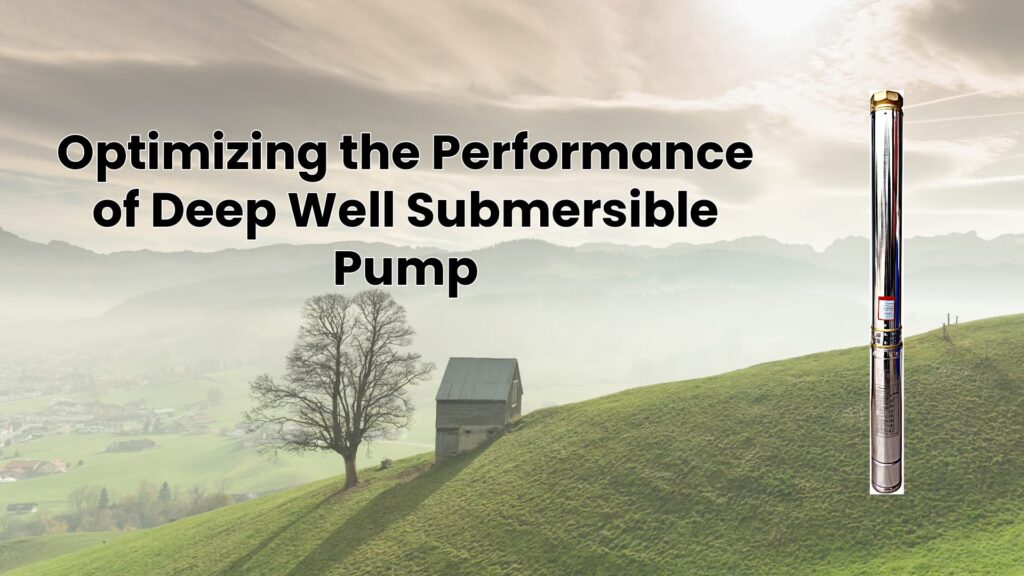
Deep well submersible pumps are vital components in many industries, from agriculture to construction, hospitality to mining. These pumps are the heart of your water supply system, ensuring that water is available when and where you need it. However, without proper care and attention, even the best submersible pumps can underperform, leading to costly downtime and repairs. This guide will walk you through everything you need to know to optimize the performance of your deep well submersible pump, ensuring it operates efficiently and reliably for years to come.
1. Choose the Right Submersible Pump for Your Needs
- Assess Your Water Demand: Before selecting a submersible pump, it’s crucial to understand your specific water needs. This includes the volume of water required, the depth of your well, and the pressure needed to move water to the surface. A submersible pump that is too powerful for your well can cause excessive energy consumption and wear, while an underpowered pump may struggle to meet your water demands, leading to frequent failures and inefficiencies.
- Match the Horsepower to Your Application: Submersible pumps come in various horsepower ratings, ranging from submersible pump 1hp to submersible pump 5hp and beyond. The horsepower of your pump should align with the depth of the well and the water pressure requirements. For example, a submersible pump 2hp might be suitable for a shallow well or a small-scale operation, while a submersible pump 4hp or submersible pump 5hp may be necessary for deeper wells or high-demand applications.
- Consider Environmental Factors: The environment in which the pump operates is also crucial. For example, submersible pumps for borewells often encounter sandy or silty conditions that require specific pump designs to prevent clogging. Similarly, a submersible pump for a fountain needs to handle continuous operation and aesthetic considerations, such as silent running.
Learn more about choosing the right pump
2. Proper Installation Is Key
- Follow Installation Best Practices: A well-installed submersible pump is less likely to encounter issues. Ensure the pump is at the correct depth, properly aligned, and that the submersible pump cable is securely connected.
- Consider Professional Installation: While DIY can be tempting, professional installation can prevent common mistakes that lead to operational inefficiencies or damage.
Explore detailed installation guidelines
3. Regular Maintenance Extends Lifespan
- Routine Checks: Regular inspection of your deep well submersible pump and motor is essential. Look for signs of wear, listen for unusual noises, and check the submersible pump impeller for blockages or damage.
- Clean and Replace Parts as Needed: Keeping your pump clean, particularly the submersible pump in well settings, prevents buildup that can hinder performance. Replace worn parts promptly to avoid larger issues.
4. Monitor Water Quality
- Protect the Pump from Debris: Sand, sediment, and other particles can damage your pump. Use a filter or screen to protect the submersible pump in pool or deep well environments.
- Regular Water Testing: Particularly in deep well farm or deep well water applications, regularly test water quality to prevent corrosion and other issues that could impact the submersible pump motor.
5. Prepare for the Unexpected with a Backup Pump
- Invest in a Backup: To avoid disruptions, especially in critical operations like deep well water pumps for irrigation or hotels, consider having a backup deep well submersible pump ready.
- Automated Systems: For high-priority applications, an automatic switchover system can ensure your operations continue smoothly, even if your primary pump fails.
Learn why a backup pump is essential
6. Optimize Energy Usage
- Right-Sized Motors: Ensure that your submersible pump motor matches the pump’s requirements. Oversized motors can waste energy, while undersized ones can be overworked.
- Energy-Efficient Models: Consider energy-efficient submersible pumps, especially if running continuously, like in irrigation or fountain applications. This not only saves on operational costs but also reduces environmental impact.
7. Stay Prepared with a Maintenance Schedule
- Regularly Scheduled Service: Set up a maintenance schedule to regularly inspect and service your deep well submersible pump. This should include checking the submersible pump cable, motor, impeller, and the general condition of the pump.
- Log and Track Issues: Keep a maintenance log to track any issues or repairs. This can help in early detection of recurring problems, allowing for timely intervention.
Conclusion
Optimizing the performance of your deep well submersible pump involves a combination of choosing the right equipment, ensuring proper installation, performing regular maintenance, and preparing for unexpected failures. By following these steps, you can ensure that your operations run smoothly, whether you’re irrigating crops, managing a construction site, or ensuring a steady water supply for a resort.
For more in-depth information and expert advice, visit the following resources:
These resources provide valuable insights to help you make the most of your submersible pump, ensuring reliable performance and long-lasting service.
